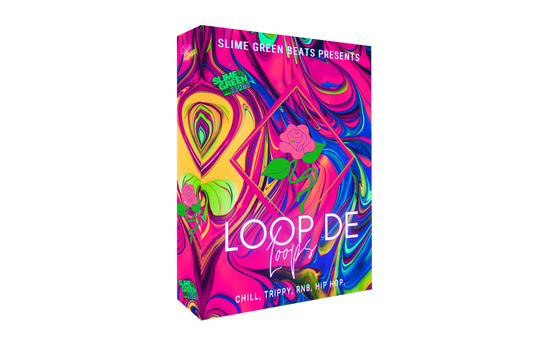Ever tried cooking with leftovers? That's kinda what using a sampler in music production feels like. You take bits and pieces of different sounds and mix them into something fresh and exciting. Whether you're pulling from old vinyl records or recording everyday noises on your phone, the art of sampling is all about creativity. With the right tools and techniques, you can turn these scraps into a masterpiece. Let's dive into how you can chop it right and make those samples sing.
Key Takeaways
- Sample chopping is like cooking with leftovers; it's creative and resourceful.
- Vinyl records are still valuable for their unique sound quality.
- DAWs and MIDI controllers are essential tools for modern sampling.
- Timing and layering are crucial techniques in sample slicing.
- Always consider legal aspects, like sample clearance, when using copyrighted material.
The Art of Sample Chopping: Making Music from Leftovers
Why Sample Chopping is Like Cooking with Leftovers
Imagine you’ve got a fridge full of random ingredients and a hunger for something new. Sample chopping is a lot like that. You take bits and pieces of existing music and whip them into something fresh and tasty. Just like turning last night’s dinner into today’s gourmet lunch, sample chopping lets you craft new beats from existing sounds. You can slice and dice your way to a masterpiece, or a musical mishap—it's all part of the fun.
The Secret Sauce: Adding Flavor to Your Beats
Every chef has a secret sauce, and in music production, it’s all about layering and effects. Add a pinch of reverb here, a dash of delay there. You can spice up your chopped samples with some EQ and compression, creating a full-bodied sound. Think of it as seasoning your dish to perfection. Maybe throw in some distortion for that extra kick.
Avoiding the Kitchen Sink: Keeping It Simple
Resist the urge to toss everything into the pot. Sometimes, less is more. You don’t want your track to sound like a chaotic mess of sounds. Pick a few choice samples, and let them shine. Here are some tips to keep it simple:
- Choose a limited number of samples.
- Focus on quality over quantity.
- Let each sound have its moment.
Sometimes, the best beats come from the simplest ingredients. A few well-chosen samples can create a track that’s both cohesive and compelling.
So, whether you're cooking up a storm in the kitchen or in the studio, remember that creativity thrives on constraints. Embrace the art of sample chopping, and let your leftover sounds become the main course.
From Vinyl to DAW: The Journey of a Sample
Why Vinyl Still Matters in a Digital World
Alright, let's talk about vinyl. You might think it's just for hipsters and collectors, but vinyl is like that secret ingredient your grandma uses in her famous pie. It's got this warmth and depth that digital just can't match. Vinyl records offer a unique sound quality that's often described as rich and full. It's not just nostalgia; it's science! The analog grooves capture nuances that digital files might miss. Plus, there's something magical about flipping through records, finding that perfect sample, and knowing you've got a piece of history in your hands.
Importing Samples: The Digital Drag and Drop
Once you've found that killer sample on vinyl, it's time to bring it into the digital realm. Think of it as teleporting your sound from the past to the future. You can record the sample into your computer using an audio interface, and then drag it into your DAW (Digital Audio Workstation). It's like moving furniture in a house, except here you're setting up your sonic living room. DAWs make it super easy to chop, edit, and manipulate your samples. You can trim the fat, add some spice, and get it ready for the main course—your track!
DAW Magic: Turning Samples into Sonic Gold
Here's where the real fun begins. DAWs are like the Swiss Army knives of music production. They let you slice, dice, and transform your samples into something entirely new. Want to speed it up? No problem. Need to pitch it down? Easy peasy. With a few clicks, you can turn a dusty old record into a fresh, modern beat. And the best part? You don't need to be a tech wizard to make it happen. Just experiment, play around, and let your creativity flow. Before you know it, you'll have a track that's uniquely yours, ready to rock the world—or at least your headphones.
Tools of the Trade: What You Need to Chop Like a Pro
DAWs: The Swiss Army Knife of Music Production
Let's face it, without a DAW (Digital Audio Workstation), you'd be chopping samples like a caveman trying to make fire with two sticks. DAWs are your best friend in the music production world. They're like the Swiss Army knife of audio – they've got everything you need to slice, dice, and season your samples to taste. Whether you're using Ableton, Logic, or FL Studio, each DAW comes with an array of built-in tools that can turn your raw sounds into polished tracks.
MIDI Controllers: Your New Best Friend
If DAWs are the Swiss Army knife, then MIDI controllers are the spatula to your musical kitchen. These handy gadgets let you play your chopped samples with the finesse of a concert pianist or the enthusiasm of a toddler banging on pots and pans. With pads and keys that trigger sounds, MIDI controllers make it easier to experiment with different sample combinations. They’re the perfect sidekick to your DAW, turning your computer into a full-blown instrument.
Hardware Samplers: Going Old School
For those who yearn for the good ol' days of music production, hardware samplers are like vinyl records – nostalgic and oh-so-satisfying. Devices like the AKAI MPC series or the Roland SP-404 are the granddaddies of sampling. They let you physically manipulate your samples, giving you a tactile connection to your music. Plus, they look super cool in your studio setup. So, if you want to keep it old school and hands-on, a hardware sampler is the way to go.
In the world of music production, having the right tools is like having the right ingredients in a kitchen. You can create something amazing with just a few key items. So, grab your DAW, plug in that MIDI controller, and maybe even dust off an old sampler. It's time to chop it like it's hot!
Chop It Like It's Hot: Techniques for Sample Slicing

The Art of Timing: When to Slice and Dice
Think of sample slicing like cutting vegetables. You want to chop at the right spots to bring out the best flavors. Timing is everything when it comes to slicing samples. Start by identifying strong beats in your track—these are your downbeats, like the first kick drum in a measure. Placing your slices here can add instant groove. If you're unsure, treat your samples like drum sounds and let them lead the rhythm.
Stacking Samples: Building a Sonic Sandwich
Why settle for a single slice when you can stack them up? Layering samples is like making a sandwich with all your favorite ingredients. Use your DAW's plugins to pitch shift samples and create harmonized layers. Stacking samples can add depth, much like adding harmony to vocals. Try experimenting with different pitches to see what flavors you can create.
Looping: The Musical Boomerang Effect
Looping is your best friend when you want to extend a sample's life. It's like taking a bite and realizing you want more. Looping a melody can form the backbone of your beat. Many classic hip-hop tracks use loops from old songs to create something fresh. So, grab a catchy riff and let it bounce back in your track.
When slicing samples, remember that less is often more. It's easy to overdo it, but sometimes a simple loop or a well-placed slice can say more than a hundred cuts.
For more on effective sample slicing, including automatic slice detection and editing options, check out the techniques that can help you craft the perfect beat.
Flipping Samples: The Musical Equivalent of a Backflip
The Flip Side: Creating New Patterns from Old Sounds
Flipping samples is like turning a plain pancake into a gourmet crepe. You take a simple sound and twist it into something fresh and exciting. Imagine slicing up an old jazz record, rearranging it, and suddenly you've got a hip-hop beat that makes everyone nod their heads. It's all about finding that sweet spot where the old meets the new, creating patterns that feel both familiar and fresh.
Reverse Engineering: Playing Samples Backwards
Ever tried walking backwards? It's weird but fun, and playing samples in reverse is kind of the same. By flipping a sound, you can uncover hidden textures and rhythms that weren't obvious before. It's like finding a secret message in your favorite song. So go ahead, hit that reverse button and see what surprises unfold.
Pitch Perfect: Changing the Game with Pitch Shifts
Pitch shifting is like giving your sample a new voice. Want to make a vocal sound like a chipmunk or a bass drop sound like a foghorn? Changing the pitch can completely alter the mood and vibe of a track. It's like dressing up your sample in a new outfit, ready for a night out. Just don't go too crazy, or you might end up with a sonic wardrobe malfunction!
Flipping samples is about breaking the rules and making your own. It's a playground where creativity knows no bounds. So grab your sampler, unleash your inner mad scientist, and see what musical magic you can create.
Here's a quick list to get you started:
- Chop it up: Break your sample into smaller bits.
- Reverse it: Play it backwards for a fresh perspective.
- Pitch it: Shift it up or down to change the vibe.
- Layer it: Stack different samples for a fuller sound.
- Loop it: Find a catchy part and repeat it to create a hook.
And if you're looking for some dreamy melodies to start with, check out the "Wonderland" Melody Loops Pack. These loops are perfect for adding depth and emotion to your tracks, whether you're a seasoned producer or just starting out. Happy flipping!
Legal Beats: Navigating the Tricky World of Sample Clearance
Sample Clearance: The Necessary Evil
Ah, sample clearance. The necessary evil of the music world. Think of it like asking your neighbor if you can borrow their lawnmower, but instead of grass, you're mowing down some sweet beats. You can't just grab a snippet of your favorite track and slap it into your song. Nope, you've got to clear that sample first! Here's how:
- Identify the Sample Owners: Find out who owns the rights to the original track. It's like a treasure hunt, but with more paperwork.
- Request Permission: This is where you put on your polite hat and ask nicely if you can use their music. A little charm goes a long way.
- Negotiate the Clearance: Sometimes, you've got to haggle a bit. It's like bargaining at a garage sale, but instead of old lamps, you're dealing with musical gold.
Royalty-Free Samples: The Safe Zone
Don't want to deal with the hassle of sample clearance? Enter royalty-free samples. They're like the fast food of music production—quick, easy, and you don't have to ask anyone's permission to use them. Just make sure they truly are royalty-free, or you might find yourself in hot water!
When in Doubt, Clear It Out
When you're unsure about whether a sample needs clearance, it's better to be safe than sorry. You don't want a lawsuit on your hands because you used a tiny piece of someone else's masterpiece. Remember, clearing samples isn't just about legality—it's about respect for the original creators.
"In the world of music, it's better to clear and cheer than to sample and scramble."
Sampling the World: Finding Sounds in Everyday Life

Field Recording: Your Smartphone is a Studio
Who knew that the magic of music production could fit right in your pocket? That's right, your smartphone is more than just a device for scrolling through cat videos; it's a mini recording studio. Field recording is all about capturing the world around you, whether it's the rhythmic clatter of a train, the chirping of birds, or even your neighbor's overly enthusiastic karaoke session. Just hit record, and you've got yourself a unique sample ready to spice up your track.
Ambient Sounds: The Music of the Mundane
Sometimes, the most unexpected sounds make the best samples. Ever thought about the hum of your fridge or the clicking of a keyboard? These ambient sounds can add a layer of depth and authenticity to your music. It's like adding a pinch of salt to your dish—subtle yet transformative. Next time you're sitting in a café, listen closely. That chatter and clinking of cups could be the next big hit.
Personalizing Your Tracks: Adding Your Unique Sound
Sampling is not just about borrowing sounds; it's about making them your own. By integrating everyday noises into your music, you create a soundscape that's uniquely yours. Think of it as adding your signature spice blend to a recipe. Whether it's your dog's bark or the sound of rain on your window, these personal touches can make your music stand out. Remember, music is all about storytelling, so let your samples tell your story.
Embrace the chaos of everyday life and turn it into art. Your surroundings are a treasure trove of sounds waiting to be discovered. With a bit of creativity, you can transform the ordinary into the extraordinary.
For more on how field recordings can enhance your tracks, dive into the world of lo-fi music and uncover the value of storytelling through sound.
Mastering the Mix: Making Your Samples Shine
EQ and Compression: The Dynamic Duo
Mixing is like cooking—it's all about balance and flavor. EQ and compression are your salt and pepper. With EQ, you can carve out space for each element in your mix, making sure your samples don't step on each other's toes. Think of it as decluttering your sonic space. Compression, on the other hand, is like that friend who keeps things in check, ensuring no one gets too loud and ruins the party. It's about controlling dynamics and making your mix sound polished.
Reverb and Delay: Adding Space to Your Sound
Now, let's talk about reverb and delay. These effects add depth and dimension, taking your samples from flat to fabulous. Reverb gives your sound a sense of space, like it's bouncing off the walls of a grand hall or a tiny closet—your choice! Delay, meanwhile, can create echoes that add rhythm and interest. Just be careful not to overdo it, or you'll end up with a muddy mess. A little goes a long way.
Balancing Act: Keeping Samples in Check
Mixing is a balancing act. You want your samples to stand out, but not at the expense of the whole track. It's like juggling, and every element needs its moment in the spotlight without overshadowing the others. Use volume faders wisely, and don't be afraid to make cuts where needed. Remember, sometimes less is more. Keep your hip hop beats tight and punchy, and your listeners will be nodding along in no time.
"In the world of mixing, every sample is a star, but it's the mix engineer who turns them into a constellation."
Mastering the mix is an art form. It's where creativity meets technical skill, and where your samples truly come to life. So, grab your headphones, trust your ears, and let your mix shine!
When it comes to making your music stand out, mixing is key. You want your samples to really pop and grab attention. Start by balancing the levels of each sound so they fit together nicely. Don’t forget to add effects like reverb or delay to give your samples more depth. If you’re looking for high-quality beats to elevate your tracks, check out our website for a great selection!
Wrapping It Up: Chop 'Til You Drop!
So there you have it, folks! You've now got the lowdown on how to slice and dice your way to musical greatness with a sampler. Remember, there's no right or wrong way to chop a sample—just like there's no right way to eat a taco (though dropping it on your shirt is a classic move). Whether you're turning a bird chirp into a beat or flipping a classic tune into something fresh, the key is to have fun and experiment. Who knows? Your next masterpiece might just be a chopped-up sound of your neighbor's dog barking. Keep those creative juices flowing and chop 'til you drop!
Frequently Asked Questions
What is sample chopping in music production?
Sample chopping is when you take a piece of music and cut it into smaller parts. These pieces are then used to create new songs or beats. It's like making a collage with music.
Why is sample chopping compared to cooking with leftovers?
Just like cooking with leftovers, sample chopping involves taking bits and pieces of existing music and turning them into something fresh and new. It's about being creative with what you have.
How do I start chopping samples in my DAW?
To chop samples in your DAW, you first import the audio file, then use tools to cut it into smaller sections. You can rearrange these sections to make new music.
Do I need special equipment to chop samples?
No, you don't need special equipment to chop samples. You can use your computer and a DAW software. However, a MIDI controller can make the process easier and more fun.
What is sample clearance, and why is it important?
Sample clearance is getting permission to use someone else's music in your own work. It's important because using music without permission can lead to legal trouble.
Can I use sounds from my environment as samples?
Yes, you can use sounds from your environment as samples. Recording sounds from everyday life can add a unique touch to your music.








